|
|
|||||
| home > architetture | |||||
| MORPHOSIS.
Caltrans District 7 Headquarters |
|||||
| Il
progetto per la nuova sede del Caltrans (Dipartimento dei trasporti
della California) nasce da una gara bandita dal California Department
of Transportation nel 2001. In seguito a una selezione internazionale
cui sono stati invitati a partecipare 11 studi di architettura, la giuria
(tra i cui membri vi erano Richard Weinstein, Preside della Scuola di
Architettura di UCLA; Sylvia Lavin, direttrice del Dipartimento di Architettura
di UCLA; Robert Timme, Preside della Scuola di Architettura di USC;
Ming Fung, fondatrice dello studio Hodgetts & Fung e direttrice
del Graduate Program di SCI-Arc) ammette alla seconda fase mOrphosis,
Rem Koolhaas e Benedetta Tagliabue. Nel novembre 2001, in seguito a
un lungo processo di verifica e selezione durato sei mesi, la giuria
nomina vincitore lo studio mOrphosis diretto da Thom Mayne. È
significativo, fa notare Nicolai Ouroussoff in un articolo sul "New
York Times" del dicembre scorso (Civic Boosterism Never Looked
So Sexy), che anche i committenti pubblici abbiano compreso che
l'architettura di qualità "is no longer just a toy for the
cultural elite". Dopo 3 anni dall'affidamento dell'incarico, l'edificio
(con una sperficie utile complessiva di circa 20,000 mq) viene inaugurato,
rispettando pienamente i tempi e i costi (175 milioni di euro) stabiliti.
Il Caltrans, che sorge sulla South Spring Street nel downtown di Los
Angeles, tra 1st e 2nd Street, non costituisce solamente una esuberante
opera di architettura, capace di creare una nuova immagine per il dipartimento
dei trasporti della California, ma rappresenta piuttosto un intervento
alla scala urbana che mira a diventare un nuovo punto di riferimento
per quest'area della città che da anni è alla ricerca
di una sua identità formale. Ricordiamo che negli ultimi anni,
in questa porzione del downtown, la stessa che secondo il Banham della
"città delle 4 ecologie" non meritava più di
una breve nota, sono sorti la Disney Concert Hall di Frank Gehry, la
Cathedral of our Lady of the Angels di Rafael Moneo e, non lontano da
qui, lo Staples Center di NBBJ, nuova arena sportiva metropolitana.
A qualche isolato di distanza, poi, c'è il SCI-Arc, Southern
California Institute of Architecture. Scrive ancora Ouroussoff: "Its
glistening metal skin and hulking form evoke the relentless faith in
the future -in social mobility, individual freedom, eternal youth- that
made Los Angeles one of the most radical urban inventions in American
history." Si tratta di un momento di affermazione cui il gruppo
guidato da Thom Mayne, pochi giorni fa insignito del Premio Pritzker,
lavorava da tempo, almeno a partire dal progetto per la Diamond Ranch
High School di Pomona. ARCH'IT presenta in anteprima per l'Italia il
progetto dello studio mOrphosis per la nuova sede del Caltrans, inaugurato
a Los Angeles il 29 novembre 2004. Paola Giaconia |
|||||
  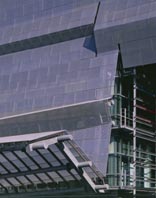 |
With
a hybridized civic orientation that blends an L.A. sensibility with
a more cosmopolitan urban tradition, the new Caltrans District 7 Headquarters
building in downtown Los Angeles is perceptually of the fabric
of the city, as opposed to being a singular object or ornament. Enrobed
in a constantly changing mechanical skin that is alternately open or
closed depending on the conditions of outside temperature and sunlight,
the building's fundamental property is that of transformation. |
[25mar2005] | |||
  At dusk the building is transparent -textured and windowed everywhere to invite the voyeur- while at mid-day it is buttoned up against the sun, appearing to be devoid of windows entirely. At night, the dark facade seems to recede in favor of the outside lobby's four-story-high light sculpture. Mimetic of the larger metropolis, this building will be perceived differently by each observer depending on his or her experience with it. Inside, normative office culture is challenged by the reversal of floor-plan layout and the incorporation of skip-stop elevators that call for the use of large, centrally located stairwell lobbies. More aptly understood as movement intensification, the stairwell lobbies create access/egress patterns that encourage familiarity and exchange while aspiring to mitigate the probability of departmental balkanization. |
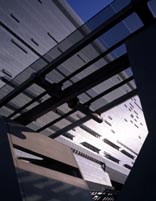  |
||||
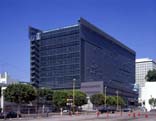 |
 Important amenities for the public, including a cafeteria, a large public outdoor lobby area, and an exhibition space, are an important element of the design, intended to create a building that contributes to the civic life of downtown Los Angeles. The design goes beyond merely providing functional spaces. It seeks in every way to engage people actively while blurring the distinction between outside and inside, so that this government bureau works as a truly public building. |
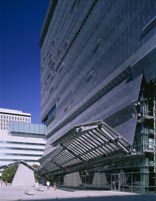 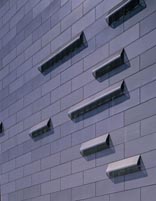 |
|||
| In
a key design gesture, Morphosis moved the main lobby from the inside
to the outside to create an outdoor room for 1,000 people with café
tables to be shared among building workers, visitors and the general
public. Pedestrian traffic on Main Street flows directly into this space,
which is defined in part by the joining of the L-shaped building's two
main sections. To engage street traffic, amenities such as the exhibition
gallery and the cafeteria are located around the outdoor lobby at ground
level. |
|||||
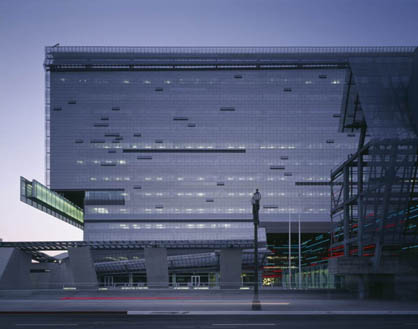 Prosaic materials, outsized structural forms, and exposed structural elements are referential to the work of Caltrans and evoke a feeling of being in, under or around the freeways themselves. The outdoor lobby is activated by an extraordinary public art installation designed in collaboration with Morphosis by the internationally acclaimed artist Keith Sonnier. Titled Motordom, the work is integrated directly into the architecture of the four story outdoor lobby, filling it with half a mile of neon and argon tubes arranged in horizontal bands of red and blue light that mimic the ribbons of headlights on California's freeways. The shifting light patterns cycle at an observable but unhurried pace of five minutes, filling and animating the outdoor lobby space while simultaneously washing through the glass curtain walls into the first four levels of the interior. Motordom is the largest public art installation in Los Angeles. |
|||||
 Marking the entrance of the building at 100 South Main Street is a super-graphic, forward-canted sign towering 40 feet over the sidewalk. Comprised of layers of opacity and transparency that break the confines of the vertical walls, this sign, with its nod to the Chandleresque L.A.'s Hollywood sign, marks the building and the institution as an urban landmark. Further references to the California roadways are apparent in a large light-bar that extends out from the First Street side of the building to cantilever out over the street and in a low yellow neon strip that wraps around the northeast corner of the building at shoulder level. The various cantilevers and extrusions are about movement, about an unrestrained exuberance that speaks directly to the car culture of Los Angeles and that serves to reinforce the raison d'être of Caltrans. |
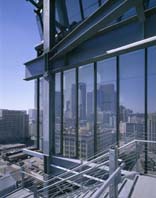 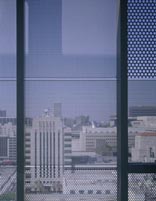 |
||||
 To emphasize the interaction between outside and inside, the design features a remarkable double facade faced on the street side with perforated aluminum panels. The panels open and close mechanically in a continually moving pattern, providing surface variety on the facade, shielding the interior from the sun and giving office workers changing views to the outside. |
|||||
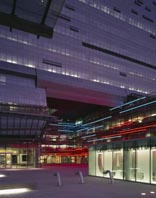  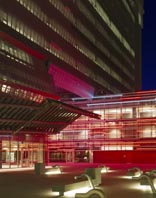 |
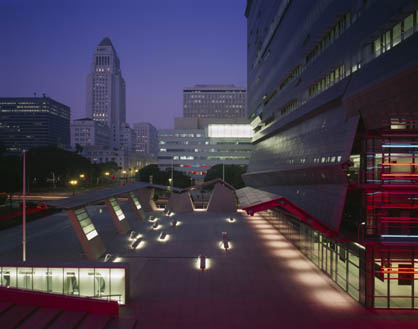 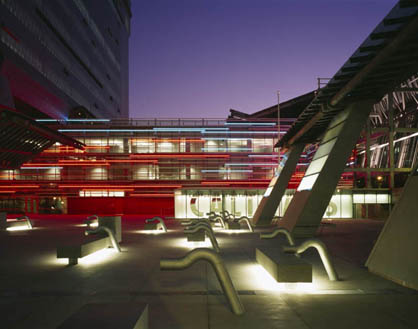 The building's equally innovative south facade is entirely surfaced with photovoltaic cells which will generate approximately 5% of the building's energy. The photovoltaic wall is in keeping with the mission of the Design Excellence Program to find environmentally sensitive design solutions that will allow the building to achieve a minimum Silver LEEDTM rating from the U.S. Green Building Council. |
  |
|||
| The
Morphosis design carries the themes of openness, interplay and sustainability
into the building's interior. Elevators operate on a “skip-stop”
basis, opening onto mini-lobbies located on every third floor: a scheme
that speeds vertical circulation, establishes interim gathering places
throughout the building and encourages those who can to use the stairs.
Floor plans reverse the usual hierarchy of office space. In the Caltrans
building, Morphosis has concentrated the private, closed-door offices
in the core of the building, so that the perimeter -and the windows-
are left free for large, open work areas that promote employee interaction. mOrphosis |
|||||
| MORPHOSIS.
Caltrans District 7 Headquarters |
|||||
 Design and construction of the new California Department of Transportation (Caltrans) District 7 Headquarters building, to serve 1,850 Caltrans employees and 500 employees of the Los Angeles Department of Transportation. The building, which also features public amenities and a significant street presence, is the first to be commissioned under the State of California’s Design Excellence Program. location: 100 South Main Street, Los Angeles, CA owner: State of California, Department of General Services design/build team. Main & First Design/Build Associates, Inc. executive architect: mOrphosis general contractor: The Clark Construction Group, Inc. developer: Urban Partners key dates: design commission awarded through competition: November 2001 design/build commence: February 2002 construction start: May 2002 tenant occupancy begins: September 2004 opening: September 27, 2004 building cost: $165 million total project cost: $190 million size: 1.05 million gross square feet: 750,000 gsf office building, 300,000 gsf underground parking garage principal exterior: Steel structure; Cynar-coated perforated aluminum panels; Eternit materials: Cement panels; Sarnafil membrane; glass principal interior: Painted drywall; exposed polished concrete in lobby; carpet; wire mesh materials: Ceiling panels; linear perforated ceiling panels mOrphosis team: Thom Mayne, Principal Silvia Kuhle, Project Manager Pavel Getov, Project Architect Anthony Mrkic, Job Captain Chandler Ahrens, Irena Bedenikovic, Tim Christ, Mario Cipresso, Ben Damron, Marty Doscher, Paul Gonzales, Salvador Hidalgo Olivia Jukic, Ted Kane, Dwoyne Keith, Kristina Loock, Jean Oei, Axel Schmitzberger, Martin Summers, Daynard Tullis clark construction: Richard Heim, President team: John Williams, Senior Vice President Marc Kersey, Project Executive urban partners: Dan Rosenfeld, Partner team: Laura Benson, Project Manager |
|||||
| Photos by Roland Halbe. | |||||
| Morphosis was founded in 1972 to develop an architecture that would eshew the normal bounds of traditional forms and materials and surpass the limiting dualism of modern and postmodern. Growing steadily, the firm is currenlty comprised of forty architects and designers directed by Thom Mayne. Thom Mayne was born in Waterbury, Connecticut in 1944. He received his Bachelor’s Degree in Architecture from the University of Southern California in 1968 and his Master’s Degree from the Graduated School of Design of Harvard University in 1978. He is one of the founding members of the Southern California Institute of Architecture (SCI-Arc), school of architecture founded by Ray Kappe in 1972. A significant percentage of Morphosis work has been commissioned through international design competitions including the Hypo-Alpe-Adria-Center in Austria, the University of Toronto Graduate Student Housing in Canada and the Diamond Ranch High School in California. Some of mOrphosis recent commissions include a Federal office building in San Francisco, a satellite operation control facility for the National Oceanic and Atmospheric Administration near Washington, D.C., and a courthouse in Eugene, Oregon. They recently won two major competitions in New York City: one being a building to house the Albert Nerken School of Engineering of the Cooper Union for the Advancement of Science and Art, and the other, an Olympic Village for the 2012 games. hom Mayne has been chosen as the 2005 Laureate of the Pritzker Architecture Prize. | |||||
| > MORPHOSIS | |||||
| Per
candidare progetti laboratorio
|
|||||